Initial release date 1 March 1995 Mode Single-player video game | ||
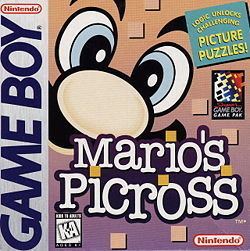 | ||
Publishers Nintendo, Nintendo of America, Nintendo of Europe Similar Jupiter Corporation games, Puzzle video games | ||
Cgrundertow mario s picross for game boy video game review
Mario's Picross (マリオのピクロス, Mario no Pikurosu) is the first in a series of Mario themed Picross titles released in the 1990s. It is a collection of nonogram logic puzzles involving a grid with numbers for every row and column, which refer to the number of marked squares within the grid. The game features Mario as an archaeologist who chisels away to form images on the grid. It was followed by two originally Japan-only sequels, Picross 2 on the Game Boy and Mario's Super Picross on the Super Famicom.
Contents
- Cgrundertow mario s picross for game boy video game review
- Mario s picross game boy tv commercial
- Gameplay
- Reception
- Sequels
- References
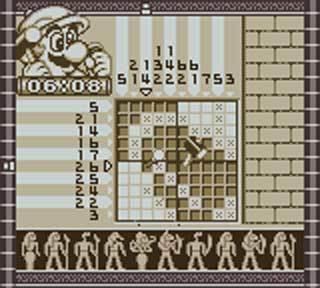
Mario s picross game boy tv commercial
Gameplay
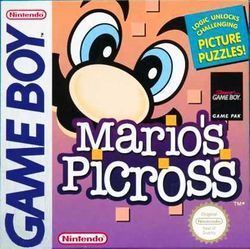
As picross is traditionally played, to solve a puzzle the player must mark a box in a window of varying sizes to create the resulting picture. The numbers on the top and left side of the window guide the correct boxes to mark (for example, if the window is 10×10, and one of the numbers at the top is a "10", that means all ten boxes in the column below it are part of the solution to the puzzle. If the numbers "5" and "4" are at the left of the window, that means that all but one of the boxes in the row next to them are correct, with five consecutive boxes, followed by four more consecutive boxes, separated by one space). The gameplay is timed, and mistakes cost time. If the player is sure the box is an incorrect box, they can mark it with an X so that they will know not to chisel it (useful for rows or columns marked with a "0"). Finally, there's a "With Hint" option available at the beginning of the puzzle. Choosing this will start a roulette with the numbers labeling the columns and rows. Pressing the A button would stop the top cursor, and pressing it again would stop the left cursor. The game would then show the answers for the resulting combination of a specific row and column. The pictures include a few Mario-related characters, food, animals, and objects.
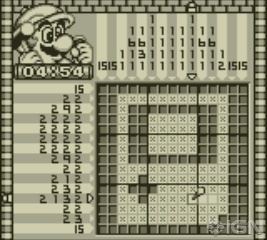
Mario Picross features 64 different puzzles in each of the four different courses — Easy Picross, Kinoko, Star and Time Trial (which has randomized puzzles), for a total of 256 puzzles. All of these follow the gameplay pattern mentioned above, except for Time Trial (which is opened after finishing all the other 192 puzzles), which is untimed and doesn't show players where they have made mistakes. If the player scores high enough they will be able to insert their score by using their initials, much like an arcade game.
Reception
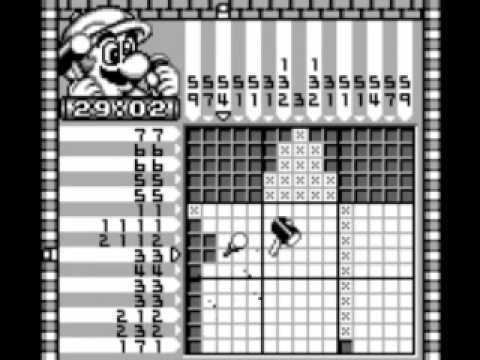
On release in Japan, Famicom Tsūshin scored the Game Boy version of the game a 29 out of 40, giving it a 9 out of 10 in their Reader Cross Review. The four reviewers of Electronic Gaming Monthly criticized the game's focus on logic and reasoning instead of rapid button presses, saying it makes the game boring to play after the first few puzzles. They gave it a 5.125 out of 10. GamePro gave it a more mixed review. They criticized the repetitive music and the fact that Mario doesn't appear in the main graphics, but acknowledged that the game is "undeniably addicting, especially if you love numbers."
Despite a large advertising campaign by Nintendo the game failed to sell well in America and Europe, leading the game's sequels to be confined to Japan. As a result, the game is seen as something of a cult classic in Western markets. The next Picross game to reach the West was 2007's non-Mario-themed Picross DS, developed by Mario's Picross developer Jupiter. This title featured downloadable puzzles from the original game and other Nintendo-developed Picross titles. One of the main criticisms aimed at the game was the size of the grids. Due to the small size of the Game Boy screen, the game's grids are restricted to being just 15x15, when puzzles four times that size were common in other media. There was also criticism of the way the game penalises time for filling a square that isn't part of the solution.
Game Informer ranked it as their 91st favourite game ever due to its addictive nature. Game Informer's Ben Reeves called it the fifth best Game Boy game.
Sequels
Picross 2 (ピクロス2) for the Game Boy is a Japan-exclusive collection of nonogram logic puzzles involving a grid with numbers for every row and column, which refer to the amount of marked squares within the grid, and the sequel to this game. Unlike this game, Picross 2 contains a world map. Also, the pictures are larger, consisting of four 15x15 picross boards. Also exclusive to Japan, Nintendo released eight volumes of Nintendo Power branded Picross games known as Picross NP that were only available via the Nintendo Power service. The game was released on the 3DS Virtual Console in Japan on October 24, 2012.
